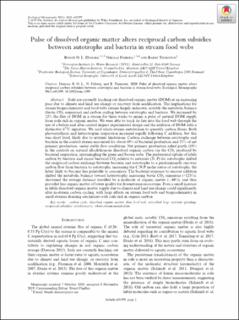| dc.contributor.author | Demars, Benoît O. L. | |
| dc.contributor.author | Friberg, Nikolai | |
| dc.contributor.author | Thornton, Barry | |
| dc.date.accessioned | 2020-07-03T10:00:46Z | |
| dc.date.available | 2020-07-03T10:00:46Z | |
| dc.date.created | 2020-02-01T22:10:09Z | |
| dc.date.issued | 2020 | |
| dc.identifier.citation | Ecological Monographs. 2020, 90 (1), e01399. | en_US |
| dc.identifier.issn | 0012-9615 | |
| dc.identifier.uri | https://hdl.handle.net/11250/2660677 | |
| dc.description.abstract | Soils are currently leaching out dissolved organic matter (DOM) at an increasing pace due to climate and land use change or recovery from acidification. The implications for stream biogeochemistry and food webs remain largely unknown, notably the metabolic balance (biotic CO2 emissions) and carbon cycling between autotrophs and bacteria. We increased by 12% the flux of DOM in a stream for three weeks to mimic a pulse of natural DOM supply from soils rich in organic matter. We were able to track its fate into the food web through the use of a before and after control impact experimental design and the addition of DOM with a distinctive δ13C signature. We used whole‐stream metabolism to quantify carbon fluxes. Both photosynthesis and heterotrophic respiration increased rapidly following C addition, but this was short lived, likely due to nutrient limitations. Carbon exchange between autotrophs and bacteria in the control stream accounted for about 49% of bacterial production and 37% of net primary production, under stable flow conditions. Net primary production relied partly (19% in the control) on natural allochthonous dissolved organic carbon via the CO2 produced by bacterial respiration, intermingling the green and brown webs. The preferential uptake of labile carbon by bacteria and excess bacterial CO2 relative to nutrients (N, P) for autotrophs shifted the reciprocal carbon exchange between bacteria and autotrophs to a predominantly one‐way carbon flow from bacteria to autotrophs, increasing the C:N:P molar ratios of autotrophs, the latter likely to become less palatable to consumers. The bacterial response to sucrose addition shifted the metabolic balance toward heterotrophy increasing biotic CO2 emissions (+125%), shortened the average distance travelled by a molecule of organic matter (−40%), and thus provided less organic matter of lower quality for downstream ecosystems. Even a small increase in labile dissolved organic matter supply due to climate and land use change could significantly alter in‐stream carbon cycling, with large effects on stream food web and biogeochemistry in small streams draining catchments with soils rich in organic carbon. | en_US |
| dc.language.iso | eng | en_US |
| dc.publisher | Ecological Society of America | en_US |
| dc.rights | Navngivelse 4.0 Internasjonal | * |
| dc.rights.uri | http://creativecommons.org/licenses/by/4.0/deed.no | * |
| dc.title | Pulse of dissolved organic matter alters reciprocal carbon subsidies between autotrophs and bacteria in stream food webs | en_US |
| dc.type | Peer reviewed | en_US |
| dc.type | Journal article | en_US |
| dc.description.version | publishedVersion | en_US |
| dc.rights.holder | © 2019 The Authors | en_US |
| dc.source.pagenumber | 20 | en_US |
| dc.source.volume | 90 | en_US |
| dc.source.journal | Ecological Monographs | en_US |
| dc.source.issue | 1 | en_US |
| dc.identifier.doi | 10.1002/ecm.1399 | |
| dc.identifier.cristin | 1789694 | |
| dc.relation.project | Norges forskningsråd: 160016 | en_US |
| cristin.ispublished | true | |
| cristin.fulltext | original | |
| cristin.qualitycode | 2 | |

